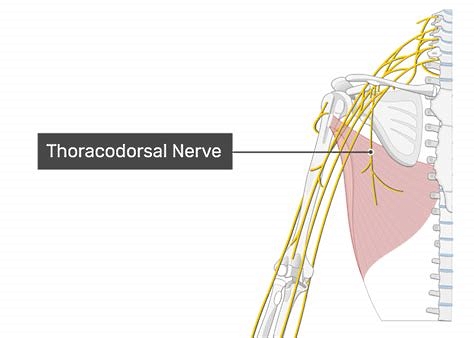[1]
Lu W, Xu JG, Wang DP, Gu YD. Microanatomical study on the functional origin and direction of the thoracodorsal nerve from the trunks of brachial plexus. Clinical anatomy (New York, N.Y.). 2008 Sep:21(6):509-13. doi: 10.1002/ca.20656. Epub
[PubMed PMID: 18698655]
[2]
Takahashi N, Watanabe K, Koga N, Rikimaru H, Kiyokawa K, Saga T, Nakamura M, Tabira Y, Yamaki K. Anatomical Research of the Three-dimensional Route of the Thoracodorsal Nerve, Artery, and Veins in Latissimus Dorsi Muscle. Plastic and reconstructive surgery. Global open. 2013 May:1(2):1-7. doi: 10.1097/GOX.0b013e3182948534. Epub 2013 Jun 7
[PubMed PMID: 25289214]
[3]
Zin T, Maw M, Oo S, Pai D, Paijan R, Kyi M. How I do it: Simple and effortless approach to identify thoracodorsal nerve on axillary clearance procedure. Ecancermedicalscience. 2012:6():255. doi: 10.3332/ecancer.2012.255. Epub 2012 May 28
[PubMed PMID: 22675404]
[4]
Anthony DJ, Basnayake BMOD, Ganga NMG, Mathangasinghe Y, Malalasekera AP. An improved technical trick for identification of the thoracodorsal nerve during axillary clearance surgery: a cadaveric dissection study. Patient safety in surgery. 2018:12():18. doi: 10.1186/s13037-018-0164-2. Epub 2018 Jun 26
[PubMed PMID: 29983745]
[5]
Musumeci G, Castrogiovanni P, Coleman R, Szychlinska MA, Salvatorelli L, Parenti R, Magro G, Imbesi R. Somitogenesis: From somite to skeletal muscle. Acta histochemica. 2015 May-Jun:117(4-5):313-28. doi: 10.1016/j.acthis.2015.02.011. Epub 2015 Apr 4
[PubMed PMID: 25850375]
[6]
Tsangaris TN, Trad K, Brody FJ, Jacobs LK, Tsangaris NT, Sackier JM. Endoscopic axillary exploration and sentinel lymphadenectomy. Surgical endoscopy. 1999 Jan:13(1):43-7
[PubMed PMID: 9869687]
[7]
Lee KS. Variation of the spinal nerve compositions of thoracodorsal nerve. Clinical anatomy (New York, N.Y.). 2007 Aug:20(6):660-2
[PubMed PMID: 17352401]
[8]
Paolini G, Longo B, Laporta R, Sorotos M, Amoroso M, Santanelli F. Permanent latissimus dorsi muscle denervation in breast reconstruction. Annals of plastic surgery. 2013 Dec:71(6):639-42. doi: 10.1097/SAP.0b013e31825c0840. Epub
[PubMed PMID: 23403547]
[9]
Al Maksoud AM, Barsoum AK, Moneer MM. Langer's arch: a rare anomaly affects axillary lymphadenectomy. Journal of surgical case reports. 2015 Dec 27:2015(12):. pii: rjv159. doi: 10.1093/jscr/rjv159. Epub 2015 Dec 27
[PubMed PMID: 26712801]
Level 3 (low-level) evidence
[10]
Taterra D, Henry BM, Zarzecki MP, Sanna B, Pękala PA, Cirocchi R, Walocha JA, Tubbs RS, Tomaszewski KA. Prevalence and anatomy of the axillary arch and its implications in surgical practice: A meta-analysis. The surgeon : journal of the Royal Colleges of Surgeons of Edinburgh and Ireland. 2019 Feb:17(1):43-51. doi: 10.1016/j.surge.2018.04.003. Epub 2018 May 22
[PubMed PMID: 29801707]
Level 1 (high-level) evidence
[11]
Soldado F, Ghizoni MF, Bertelli J. Thoracodorsal nerve transfer for triceps reinnervation in partial brachial plexus injuries. Microsurgery. 2016 Mar:36(3):191-7. doi: 10.1002/micr.22386. Epub 2015 Jan 29
[PubMed PMID: 25639376]
[12]
Soldado F, Ghizoni MF, Bertelli J. Thoracodorsal nerve transfer for elbow flexion reconstruction in infraclavicular brachial plexus injuries. The Journal of hand surgery. 2014 Sep:39(9):1766-70. doi: 10.1016/j.jhsa.2014.04.043. Epub 2014 Jun 13
[PubMed PMID: 24934602]
[13]
Szychta P, Butterworth M, Dixon M, Kulkarni D, Stewart K, Raine C. Breast reconstruction with the denervated latissimus dorsi musculocutaneous flap. Breast (Edinburgh, Scotland). 2013 Oct:22(5):667-72. doi: 10.1016/j.breast.2013.01.001. Epub 2013 Jan 30
[PubMed PMID: 23374963]
[14]
Layeeque R, Hochberg J, Siegel E, Kunkel K, Kepple J, Henry-Tillman RS, Dunlap M, Seibert J, Klimberg VS. Botulinum toxin infiltration for pain control after mastectomy and expander reconstruction. Annals of surgery. 2004 Oct:240(4):608-13; discussion 613-4
[PubMed PMID: 15383788]
[15]
Bolla M, Pasteuris C, Pillet G, Vincent P, Loiseau D. [Causes of failure in the curative treatment of cancer of the exocrine pancreas]. Bulletin du cancer. 1990:77(3):299-304
[PubMed PMID: 2340357]
[16]
Dennis M, Granger A, Ortiz A, Terrell M, Loukos M, Schober J. The anatomy of the musculocutaneous latissimus dorsi flap for neophalloplasty. Clinical anatomy (New York, N.Y.). 2018 Mar:31(2):152-159. doi: 10.1002/ca.23016. Epub 2017 Dec 28
[PubMed PMID: 29178203]
[17]
Perovic SV, Djinovic R, Bumbasirevic M, Djordjevic M, Vukovic P. Total phalloplasty using a musculocutaneous latissimus dorsi flap. BJU international. 2007 Oct:100(4):899-905; discussion 905
[PubMed PMID: 17822468]
[18]
Vesely J, Hyza P, Ranno R, Cigna E, Monni N, Stupka I, Justan I, Dvorak Z, Novak P, Ranno S. New technique of total phalloplasty with reinnervated latissimus dorsi myocutaneous free flap in female-to-male transsexuals. Annals of plastic surgery. 2007 May:58(5):544-50
[PubMed PMID: 17452841]
[19]
Kwon ST, Chang H, Oh M. Anatomic basis of interfascicular nerve splitting of innervated partial latissimus dorsi muscle flap. Journal of plastic, reconstructive & aesthetic surgery : JPRAS. 2011 May:64(5):e109-14. doi: 10.1016/j.bjps.2010.12.008. Epub
[PubMed PMID: 21300582]
[20]
George MS, Khazzam M. Latissimus Dorsi Tendon Rupture. The Journal of the American Academy of Orthopaedic Surgeons. 2019 Feb 15:27(4):113-118. doi: 10.5435/JAAOS-D-17-00581. Epub
[PubMed PMID: 30278013]
[21]
Donohue BF, Lubitz MG, Kremchek TE. Sports Injuries to the Latissimus Dorsi and Teres Major. The American journal of sports medicine. 2017 Aug:45(10):2428-2435. doi: 10.1177/0363546516676062. Epub 2016 Dec 20
[PubMed PMID: 28125914]
[22]
Lazio BE, Staab M, Stambough JL, Hurst JM. Latissimus dorsi rupture: an unusual complication of anterior spine surgery. Journal of spinal disorders. 1993 Feb:6(1):83-6
[PubMed PMID: 8439723]

